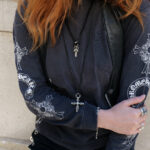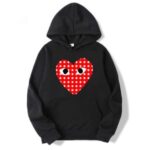In a world where fashion and art increasingly blur their boundaries, few figures capture this intersection as vividly as Labubu . Created by Hong Kong-based artist Kasing Lung, Labubu has transcended its origin as a designer toy to become a cultural symbol, representing a new wave of emotional aesthetics in contemporary style. With its mischievous grin, melancholic eyes, and unpolished charm, Labubu stands as both a visual delight and a complex emotional emblem, redefining what it means to be fashionable in today’s expressive age.
The Emotional DNA of Labubu
At first glance, Labubu seems whimsical—a creature somewhere between a rabbit, an imp, and a fairy-tale monster. Yet beneath its playful façade lies a surprising depth of emotion. Kasing Lung’s creation embodies the contradictions of modern identity: innocence mixed with cynicism, humor infused with sadness, and a certain rebelliousness that challenges polished ideals of beauty.
Labubu’s face, with its exaggerated features and haunting expression, captures the nuances of feeling often hidden beneath curated images of perfection. It represents the messy, imperfect emotions that define human experience. In fashion, this same raw honesty has become increasingly valued. Designers today seek to evoke emotion, not just admiration. Labubu’s aesthetic mirrors this shift—an embrace of authenticity, vulnerability, and imperfection as the new markers of style.
From Toy Shelf to Runway Inspiration
Labubu’s influence has stretched far beyond toy collections and art galleries. In recent years, its quirky design language has begun to infiltrate contemporary fashion. Streetwear brands, high-end designers, and even avant-garde stylists have referenced Labubu’s look in subtle yet impactful ways. Oversized silhouettes, distorted proportions, and playfully eerie motifs echo its design philosophy.
Much like Kasing Lung’s blending of the cute and the grotesque, many fashion designers experiment with the same emotional paradox. They seek to craft garments that stir something within—pieces that make wearers feel rather than merely look good. Labubu’s mischievous grin can be found in the spirit of fashion movements that reject conventional beauty, embracing weirdness as a form of self-expression.
In the same way that Labubu’s collectors feel emotionally attached to their figures, fashion consumers today crave emotional connections with the clothes they wear. This emotional investment transforms fashion from a material pursuit into a personal narrative, one where garments and objects—like Labubu—serve as extensions of selfhood.
The Rise of Emotional Fashion
Fashion has always reflected cultural moods. In an era dominated by social media, economic uncertainty, and digital overload, people are seeking emotional refuge through creativity. The rise of “emotional fashion”—a trend emphasizing feeling, storytelling, and nostalgia—is a response to that longing for connection.
Labubu’s aesthetic perfectly embodies this movement. Its world is whimsical but tinged with melancholy, much like the bittersweet tone of contemporary life. Through Kasing Lung’s hand-painted details, every Labubu figure tells a story, often one of loneliness, curiosity, and wonder. Similarly, emotional fashion invites wearers to dress their emotions—to externalize what lies inside.
Designers like Rei Kawakubo of Comme des Garçons, Demna of Balenciaga, and Simone Rocha have all explored this territory. They use texture, silhouette, and color not just to decorate but to communicate. The distressed, the deconstructed, and the strange have become the vocabulary of emotional expression. Labubu, too, thrives in this language—a creature that is simultaneously beautiful and unsettling, mirroring the human psyche’s contradictions.
Nostalgia and the Child Within
One of Labubu’s most potent emotional appeals lies in its ability to awaken nostalgia. The figure’s design evokes childhood memories—not the sanitized version of fairy tales, but the darker, dreamlike ones where danger and delight coexist. This nostalgic quality aligns with a broader cultural yearning for innocence amid chaos.
In fashion, nostalgia functions similarly. The resurgence of retro aesthetics, from Y2K to 90s grunge, reveals a collective desire to reconnect with simpler, more emotionally resonant times. Labubu’s world taps into that desire by blending the comfort of childhood imagination with the sophistication of adult artistry. It invites people to revisit their inner child without embarrassment, to find power in playfulness.
When fashion embraces this nostalgia, it becomes emotionally layered. A sweater with a hand-drawn character or a pair of sneakers inspired by childhood cartoons does more than appeal to style—it touches the soul. Labubu’s aesthetic has inspired collaborations and streetwear designs that capitalize on this fusion of innocence and irony, reminding wearers that vulnerability can be fashionable.
Imperfection as Beauty
In a marketplace obsessed with perfection, Labubu’s charm lies in its deliberate imperfection. Each figure, slightly asymmetrical or rough around the edges, celebrates the beauty of flaws. This aesthetic philosophy echoes the Japanese concept of wabi-sabi—the acceptance of transience and imperfection.
Contemporary fashion has increasingly adopted this mindset. Distressed fabrics, unfinished hems, and irregular patterns have become signs of artistic authenticity rather than errors. Labubu’s texture and facial expression remind us that perfection can be sterile, while imperfection carries warmth and soul.
By rejecting polished aesthetics, Labubu symbolizes emotional honesty. It reflects the imperfections within all of us and invites us to wear them with pride. This perspective has given rise to fashion movements centered around mental health, individuality, and vulnerability—where emotional transparency becomes the ultimate accessory.
The Cultural Language of Labubu
Beyond its physical design, Labubu functions as a cultural language—a form of emotional communication that transcends words. Collectors don’t just buy Labubu figures; they share stories, photos, and experiences that form a global community bound by shared feeling. In this sense, Labubu operates much like fashion itself: a tool for identity construction and social belonging.
Just as one’s choice of clothing can Labubu Doll express mood or personality, owning a Labubu can signify participation in a certain emotional culture—one that values sincerity, artistry, and empathy. Both fashion and Labubu act as intermediaries between the self and society, allowing individuals to articulate emotions that might otherwise remain unspoken.
Conclusion: Wearing Emotion in the Age of Expression
Labubu’s aesthetic is more than visual—it is emotional, cultural, and deeply human. In the age of curated images and algorithmic beauty, its raw sincerity feels radical. It reminds us that true style is not about perfection but about presence; not about trends, but about truth.

